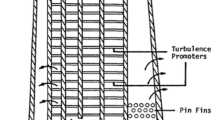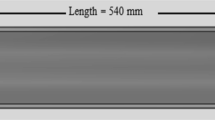Abstract
The present work represents a two-dimensional numerical prediction of forced turbulent flow heat transfer through a grooved tube. Four geometric groove shapes (circular, rectangular, trapezoidal and triangular) were selected to perform the study, as well as two aspect ratios of groove-depth to tube diameter (e/D = 0.1 and 0.2). The study focuses on the influence of the geometrical shapes of grooves and groove-depth on heat transfer and fluid flow characteristics for Reynolds number ranging from 10,000 to 20,000. The characteristics of Nusselt number, friction factor and entropy generation are studied numerically by the aid of the computational fluid dynamics (CFD) commercial code of FLUENT. It is observed that the best performance occurs with the lower depth-groove ratio, whereas it is found that the grooved tube provides a considerable increase in heat transfer at about 64.4 % over the smooth tube and a maximum gain of 1.52 on thermal performance factor is obtained for the triangular groove with (e/D = 0.1).













Similar content being viewed by others
Abbreviations
- B :
-
Groove width, m
- C μ :
-
Turbulence model constant
- D :
-
Tube diameter, m
- D h :
-
Hydraulic diameter, (= D), m
- e :
-
Groove depth, m
- f :
-
Friction factor
- G k :
-
TKE generation rate
- h :
-
Heat transfer coefficient, W/m2 K
- k :
-
Turbulent kinetic energy
- k f :
-
Thermal conductivity of fluid, W/m K
- L :
-
Length of test tube, m
- \( \dot{m} \) :
-
Mass flow rate, kg/s
- Nu :
-
Nusselt number
- P :
-
Pressure, Pa
- Pr :
-
Prandtl number
- q′ :
-
Heat transfer rate per tube length, W/m
- q″ :
-
Heat flux, W/m2
- Re :
-
Reynolds number, Re = ρu D h/μ
- s :
-
Entropy, kJ/kg K
- S :
-
Groove pitch, m
- T :
-
Temperature, K
- u :
-
Mean velocity, m/s
- \( u^{\prime }_{ij} \) :
-
Fluctuation velocity components, m/s
- Γ :
-
Thermal diffusivity
- ε :
-
Turbulent dissipation rate, m2/s3
- η :
-
Thermal enhancement factor
- μ :
-
Viscosity, kg/m s
- μ t :
-
Eddy viscosity, kg/m s
- ρ :
-
Density, kg/m3
- τ ij :
-
Reynolds stress, m2/s2
- τ w :
-
Wall shear stress, Pa
- ω :
-
Turbulent specific dissipation rate, 1/s
- b:
-
Bulk
- gen:
-
Generation
- in:
-
Inlet
- loc:
-
Local
- s:
-
Smooth
- t:
-
Turbulent
- w:
-
Wall
- TKE:
-
Turbulence Kinetic Energy
- CrGT:
-
Circular shape groove
- RcGT:
-
Rectangular shape groove
- TgGT:
-
Triangular shape groove
- TzGT:
-
Trapzoidual shape groove
References
Karwa R, Solanki SC, Saini JS (1999) Heat transfer coefficient and friction factor correlations for the transitional flow regime in rib-roughened rectangular ducts. Int J Heat Mass Transf 42(9):1597–1615
San JY, Huang WC (2006) Heat transfer enhancement of transverse ribs in circular tubes with consideration of entrance effect. Int J Heat Mass Transf 49(17–18):2965–2971
Kakac S, Shah RK, Aung W (1987) Handbook of single-phase convective heat transfer. Wiley Interscience, New York
Dalle Donne M, Meyer L (1977) Turbulent convective heat transfer from rough surfaces with two-dimensional rectangular ribs. Int J Heat Mass Transf 20:583–620
Martin SR, Bates CJ (1992) Small-probe-volume laser Doppler anemometry measurements of turbulent flow near the wall of a rib-roughened channel. Flow Measurement Instrumentation 3:81–88
Hong YM, Hsieh SS (1993) Heat transfer and friction factor measurement in ducts with staggered and inline ribs. J Heat Transfer 115:58–65
Jaurker AR, Saini JS, Gandhi BK (2006) Heat transfer and friction characteristics of rectangular solar air heater duct using rib–grooved artificial roughness. Sol Energy 80:895–907
Lorenz S, Mukomilow D, Leiner W (1995) Distribution of the heat transfer coefficient in a channel with periodic transverse grooves. Exp Thermal Fluid Sci 11:234–242
Ceylan K, Kelbaliyev G (2003) The roughness effects on friction and heat transfer in the fully developed turbulent flow in pipes. Appl Therm Eng 23(5):557–570
Webb RL, Eckert ERG, Goldstein RJ (1971) Heat transfer and friction in tubes with repeated-rib roughness. Int J Heat Mass Transf 14:601–617
Sparrow EM, Koram KK, Charmchi M (1980) Heat transfer and pressure drop characteristics induced by a slat blockage in a circular tube. J Heat Transfer 102:64–70
Kiml R, Magda A, Mochizuki S, Murata A (2004) Rib-induced secondary flow effects on local circumferential heat transfer distribution inside a circular rib-roughened tube. Int J Heat Mass Transf 47(6–7):403–412
Bilen Kadir, Cetin Murat, Gul Hasan, Balta Tuba (2009) The investigation of groove geometry effect on heat transfer for internally grooved tubes. Appl Therm Eng 29:753–761
Chaube A, Sahoo PK, Solanki SC (2006) Analysis of heat transfer augmentation and flow characteristics due to rib roughness over absorber plate of a solar air heater. Renewable Energy 31:317–331
Saidi A, Sunden B (2000) Numerical simulation of turbulent convective heat transfer in square ribbe d ducts. Numer Heat Transfer 38(1):67–88
Tatsumi K, Iwai H, Inaoka K, Suzuki K (2003) Numerical analysis for heat transfer characteristics of an oblique discrete rib mounted in a square duct. Numer Heat Transfer 44(8):811–831
Yang YT, Hwang CW (2004) Numerical calculations of heat transfer and friction characteristics in rectangular ducts with slit and solid ribs mounted on one wall. Numer Heat Transfer 45(4):363–375
Luo DD, Leung CW, Chan TL, Wong WO (2005) Flow and forced-convection characteristics of turbulent flow through parallel plates with periodic transverse ribs. Numer Heat Transfer 48(1):43–58
Kim KY, Lee YM (2007) Design optimization of internal cooling passage with V-shaped ribs. Numer Heat Transfer 51(11):1103–1118
Eiamsa-ard Smith, Promvonge Pongjet (2008) Numerical study on heat transfer of turbulent channel flow over periodic grooves. Int Commun Heat Mass Transfer 35:844–852
Launder BE, Spalding DB (1972) Lectures in mathematical models of turbulence Academic Press, London
Fluent 6.3 (2005) User’s Guide
Incropera F, Dewitt PD (1996) Introduction to heat transfer, 3rd edition John Wiley & Sons Inc
Author information
Authors and Affiliations
Corresponding author
Rights and permissions
About this article
Cite this article
Ramadhan, A.A., Al Anii, Y.T. & Shareef, A.J. Groove geometry effects on turbulent heat transfer and fluid flow. Heat Mass Transfer 49, 185–195 (2013). https://doi.org/10.1007/s00231-012-1076-9
Received:
Accepted:
Published:
Issue Date:
DOI: https://doi.org/10.1007/s00231-012-1076-9




